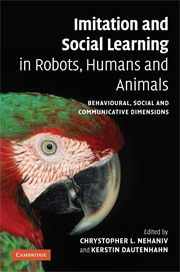 Imitation and Social Learning in Robots, Humans and Animals
Imitation and Social Learning in Robots, Humans and Animals Book contents
- Frontmatter
- Contents
- List of plates
- List of figures
- List of tables
- List of contributors
- Introduction: the constructive interdisciplinary viewpoint for understanding mechanisms and models of imitation and social learning
- Part I Correspondence problems and mechanisms
- 1 Imitation: thoughts about theories
- 2 Nine billion correspondence problems
- 3 Challenges and issues faced in building a framework for conducting research in learning from observation
- Part II Mirroring and ‘mind-reading’
- Part III What to imitate?
- Part IV Development and embodiment
- Part V Synchrony and turn-taking as communicative mechanisms
- Part VI Why imitate? – Motivations
- Part VII Social feedback
- Part VIII The ecological context
- Index
- Plate section
- References
2 - Nine billion correspondence problems
Published online by Cambridge University Press: 10 December 2009
- Frontmatter
- Contents
- List of plates
- List of figures
- List of tables
- List of contributors
- Introduction: the constructive interdisciplinary viewpoint for understanding mechanisms and models of imitation and social learning
- Part I Correspondence problems and mechanisms
- 1 Imitation: thoughts about theories
- 2 Nine billion correspondence problems
- 3 Challenges and issues faced in building a framework for conducting research in learning from observation
- Part II Mirroring and ‘mind-reading’
- Part III What to imitate?
- Part IV Development and embodiment
- Part V Synchrony and turn-taking as communicative mechanisms
- Part VI Why imitate? – Motivations
- Part VII Social feedback
- Part VIII The ecological context
- Index
- Plate section
- References
Summary
Matching behaviours
Numerous insightful descriptions of mechanisms that could be responsible for generating particular examples of social learning and related phenomena in ethology and psychology have been described (see e.g. Zentall and B. G. Galef, 1988; Heyes and Galef, 1996; Tomasello and Call, 1997; Byrne and Russon, 1998; Byrne, 1999; Heyes and Ray, 2000; Dautenhahn and Nehaniv, 2002). For robotics and software, particular general methods for solving such problems have been proposed by Nehaniv and Dautenhahn (2001) and Alissandrakis et al. (2002). Despite variations in embodiments and what they afford agents (biological, software or robots), this raises the possibility for harnessing sociality and of an artificial basis for cultural transmission of skills in societies of artifacts, which might also learn from and interact with humans (Dautenhahn, 1995; Billard and Dautenhahn, 1998; Alissandrakis et al., 2003a, b; Chapter 12, this volume).
To formulate problems of matched behaviour in general, we use the following variant of Mitchell's (1987) definition of imitation for what we will call matching behaviour:
A behaviour C is produced by an organism and/or machine, where
C is similar to another behaviour M,
Registration of M is necessary for the production of C, and
C is designed to be similar to M.
Note that novelty and learning are not explicitly required here, and whether or not the entire behaviour, or its application, or its components or some combination of them is novel or being learned is left open (see Whiten, 2002b; Dautenhahn and Nehaniv, 2002).
- Type
- Chapter
- Information
- Imitation and Social Learning in Robots, Humans and AnimalsBehavioural, Social and Communicative Dimensions, pp. 35 - 46Publisher: Cambridge University PressPrint publication year: 2007
References
- 2
- Cited by


